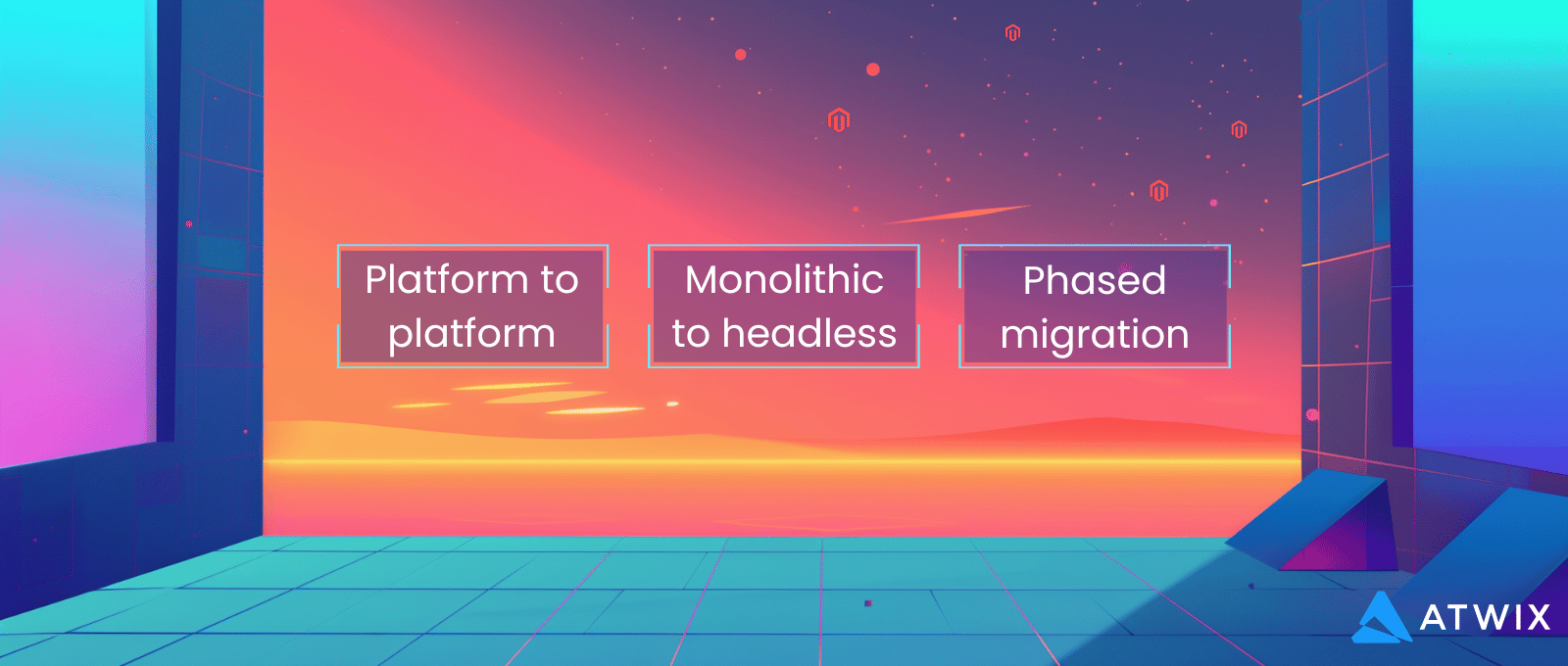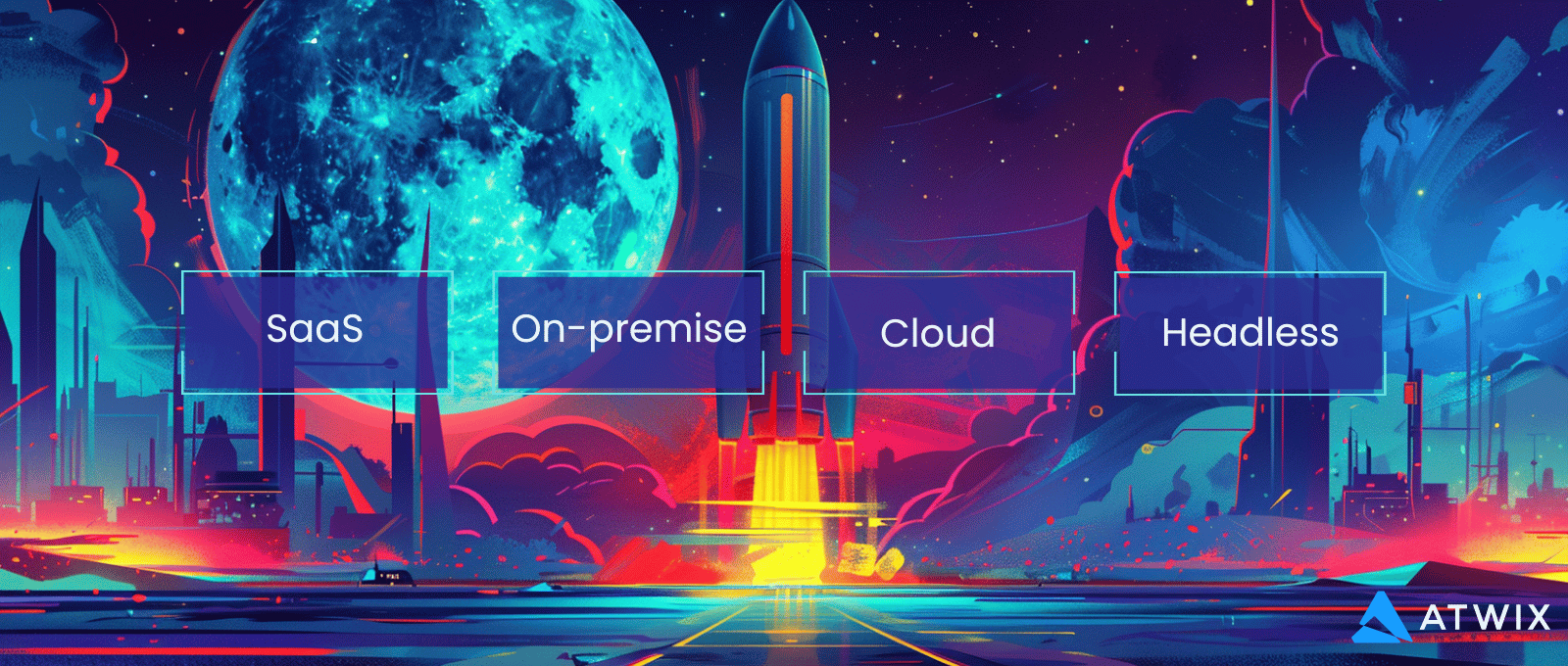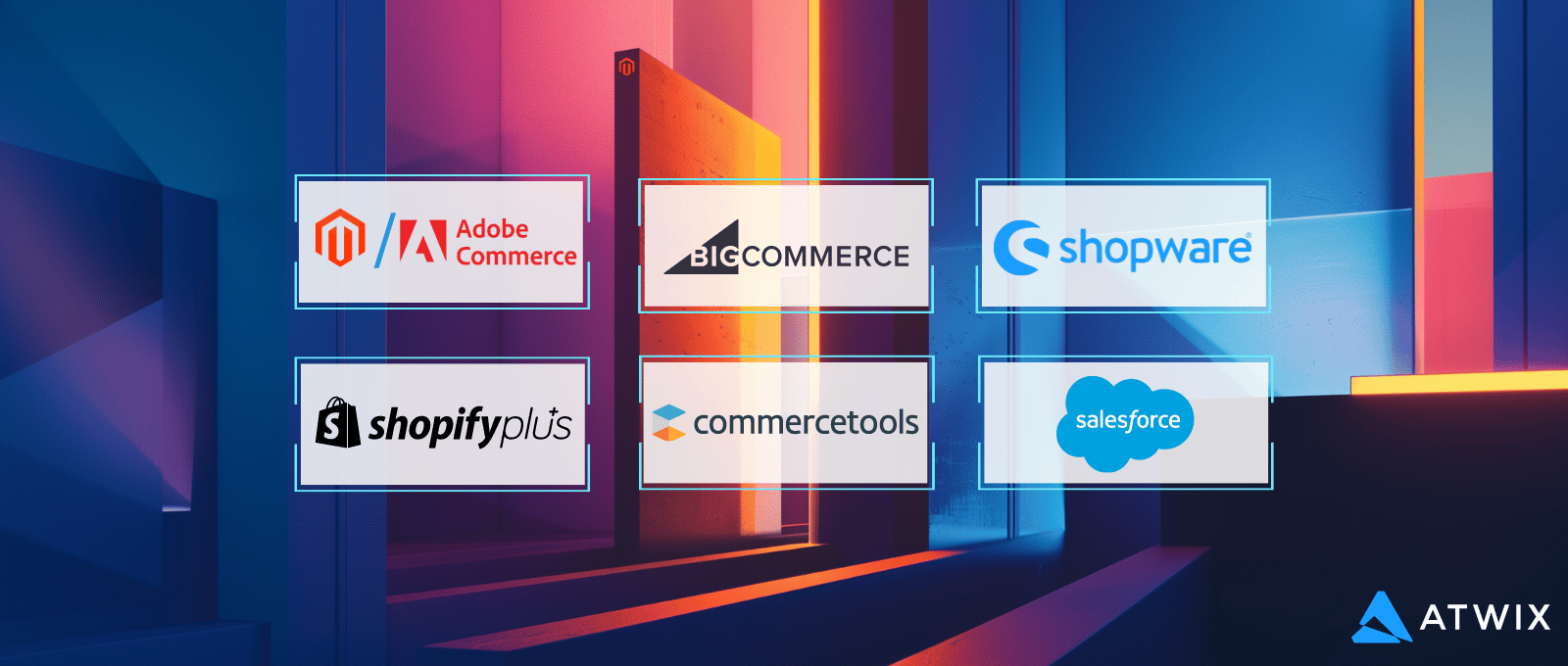61% of B2B eСommerce websites plan to migrate to a new platform in the upcoming year to adapt to the changes in customer needs and business demands. Understanding the available eCommerce platform types and migration options can help you choose the best approach for transferring all your data while avoiding failures or performance issues.
Atwix is an full-service eCommerce agency specializing in end-to-end implementations, migrations, design and development, performance enhancements, continuous Magento website maintenance , and support.
With about two-decades s of experience, we handle Magento migrations with ease. Whether you’re moving your store from a completely different platform or migrating from Magento 1 to Magento Commerce 2, Atwix will make transferring your data, functionality, and design seamless.
In this article, we share insights and guidance for navigating the challenging process of migrating an eCommerce store to a new platform. You will learn about different eCommerce platform types, migration options, and things to consider when choosing a solution for successful replatforming. Continue reading to learn how to ensure a smooth eCommerce store transition.
A Variety of eCommerce Migration Options

eCommerce stores migrate to new platforms for new capabilities, due to poor website performance, scalability limitations, a high total cost of ownership, or the inability of their current solution to provide omnichannel selling options. Businesses seek to boost eCommerce platforms with enhanced functionality, scalability, cost-effectiveness, and adaptability to meet evolving market demands. Here are the key eCommerce platform migration options.
- Platform to platform
- Monolith to headless
- Phased migration
Platform to Platform
Moving from one eCommerce solution to another, commonly known as a platform-to-platform migration, is a versatile approach catering to diverse scenarios. It can involve transitioning from one Software as a Service (SaaS) platform to another (Shopify to Magento Cloud), from an outdated to a newer version (Magento 1 to Magento 2), between monolithic solutions, or from an on-premise to a cloud-based platform.
When choosing the right eCommerce platform for migration, it is essential to assess the unique needs of your business to identify the most fitting platform that aligns with your goals. Evaluate the features, scalability, and support the target platform provides, ensuring they meet your specific requirements. Additionally, plan your data migration to ensure a smooth transfer, pluspreserve the integrity and continuity of your online operations.
Monolith to Headless
Monolith to headless migration requires decoupling the front-end from the back-end of an eCommerce platform. This architectural shift provides developers with enhanced flexibility and customization options. During this migration, the front-end and back-end components operate independently, allowing for more agile development and the incorporation of third-party APIs.
When considering a headless architecture for your eCommerce platform, focus on its benefits, like enhanced agility and performance. Evaluate compatibility with existing systems and plan for seamless communication through comprehensive testing.
Phased Migration
In a phased migration, the transition from one platform to another is incremental. It addresses specific modules or components of the eCommerce ecosystem at a time. Unlike other eCommerce platform migration options, a phased approach allows businesses to manage the process in stages. This method is suitable for organizations prioritizing minimal disruption and risks, as it enables ongoing operations during the migration.
When going for a phased migration, you must identify critical modules for independent transition, plan a timeline to minimize operational impact and maintain transparent communication with stakeholders to manage expectations effectively.
Types of eCommerce Platforms

There are several eCommerce platform types, each with its pros and cons. The choice will depend on your needs and current tech stack. Knowing the platform types for eCommerce migration and their capabilities will help you to identify the best solution for a smooth transition.
SaaS
SaaS, or Software as a Service, refers to subscription-based platforms developed by third-party vendors. This type is ideal for companies with resource constraints. SaaS solutions facilitate a quick platform setup while shifting security, maintenance, and customization control to the vendor.
On-Premise
On-premise solutions are built and maintained internally using in-house resources and developers. While offering complete control, this approach needs more care in terms of both maintenance and talent. Businesses with specific customization needs and a preference for in-house control oftenopt for on-premise solutions.
Cloud
Cloud platforms operate as a hybrid between SaaS and on-premise. Cloud platforms follow an Infrastructure as a Service (IaaS) model and are hosted by third-party providers like Amazon or Google. While the central platform is often built internally, external providers handle hosting and security. It allows for a balance between customization control and the benefits of external hosting and security expertise.
Headless
Regardless of their underlying structure (SaaS, on-premise, or cloud), headless systems require decoupling front-end and back-end components. Headless architectures provide enhanced flexibility and customization options. This approach allows businesses to adapt to changing market demands while benefiting from the chosen platform type.
Key eCommerce Platform Features
Every online store has different requirements, and the solution’s capacity to address your day-to-day issues will determine which eCommerce platform is best for you. Still, there are some fundamentals you should find out about your potential suppliers before deciding.
- Hosting environment. Assess the hosting capabilities to ensure optimal performance, reliability, and scalability. It includes SSL, shopping cart software, security measures, and payment processing services.
- Security. Adherence to PCI Compliance standards is essential for processing payments. Failure to comply can result in fines, the termination of payment acceptance capabilities, declining customer trust, and other fraud-related financial consequences.
- Search engine optimization (SEO). Opt for platforms with built-in SEO tools to enhance visibility and drive organic traffic. Mobile-friendliness, relevant keywords, page load speed, and website layout affect your SEO ranking.
Things to Consider When Choosing eCommerce Platforms
Knowing essential functionality requirements and eCommerce platform types, what other attributes should you consider when choosing a platform to migrate to? We highlight four in this article.
Budget
A common budgeting oversight is overlooking hidden costs for maintaining or scaling eCommerce solutions. Consider the upfront investment and the rising costs as you grow your market share. Opt for solutions that ensure cost scalability aligned with growth. Additionally, consider expenses for web design, platform development, custom app creation, cybersecurity, monthly hosting, maintenance, and licensing when determining your budget.For example, a SaaS solution pricing is typically more impacted by high-growth than an On-Premise platform.
Target Market
The core function of an eCommerce platform is to connect with your target audience online and facilitate sales. Choosing a platform that simplifies targeted marketing on channels relevant to your customers is imperative. Emphasizing omnichannel delivery ensures a comprehensive reach and engagement with thetarget audience.
Scalability
Assessing how seamlessly a chosen platform scales with your business is crucial. Opt for a platform that both suits your current requirements and allows for cost-effective scalability as your business expands. Avoid eCommerce solutions that lack flexibility or can’t scale reasonably.
Platform Customer Service
Give preference to eCommerce platform vendors who offer excellent maintenance and customer support. Inquire about the support channels and operation hours. Your business must get support as soon as possible to resolve issues promptly. Excellent customer service has a positive impact on both your team and client interactions.
Top Enterprise eCommerce Platforms

Here are the top eCommerce platforms for migration, each catering to unique business needs and preferences with distinct pros, cons, and pricing structure:
Adobe Commerce (Magento)
Adobe Commerce, previously Magento, is a self-hosted open-source platform for larger eCommerce stores. Migrating to Magento 2 with Atwix brings numerous benefits. Magento’s open-source architecture streamlines implementation, reducing the Total Cost of Ownership. With an impressive project duration averaging 3-5 months, Magento stands out as the fastest time-to-market solution among key competitors.
Its flexibility, extensive ecosystem, and global reach capabilities position Magento as the preferred choice for businesses seeking swift growth and international market expansion.
Key Features
- Streamlined ordering
- Customer segmentation
- Efficient inventory management
- Quote requests
- Customer relationship management
- Advanced security measures
- Business intelligence.
Pros
- Integrations with Adobe software
- Thousands of extensions, varying in price from $0 to $15,000.
- Progressive Web Applications (PWAs) support.
Cons
- No automatic feature and version update
- Intricate setup.
Pricing
BigCommerce
BigCommerce offers marketing and analytics, robust design options, and ample industry support. With the combined benefits of a SaaS platform and the flexibility of an open-source approach, BigCommerce accommodates diverse business needs, allowing varying levels of control over the platform.
Key Features
- Unlimited products, file storage, and bandwidth
- Single-page checkout
- Product videos
- Customer groups and segmentation
- Abandoned cart saver
Pros
- Intuitive built-in features
- Over 65 payment solutions and 600 app partners
- 24/7 customer service.
Cons
- Platform lock-in, involving migration and export costs
- Limited app marketplace.
Pricing
- Standard: $39/month
- Plus: $105/month
- Pro: $399/month
- Enterprise: custom pricing.
Shopware
Shopware is a versatile eCommerce solution known for its modular architecture, allowing for highly customizable online stores. It’s designed for businesses of all sizes, providing tools for deep customer engagement and storytelling as well as advanced b2b features.
Key Features
- Advanced content management system
- Powerful SEO capabilities
- Flexible product management
- Wide range of plugins and themes
Pros
- Highly customizable and scalable
- Strong community and developer support
- Suitable for both B2C and B2B business models
Cons
- May require technical expertise for advanced customization
- Limited market share outside Europe
Pricing
- Shopware offers a Community Edition that is free. Professional and Enterprise editions have custom pricing based on the scope of the project.
Shopify Plus
Shopify Plus is the enterprise version of Shopify, designed for high-volume and fast-growing businesses. It offers scalability, reliability, and advanced features for large online stores.
Key Features
- Unlimited bandwidth and transactions
- Advanced Shopify apps and themes
- Dedicated support team
- High API call limit
Pros
- Scalable infrastructure
- Extensive app ecosystem
- User-friendly interface
Cons
- Higher cost compared to Shopify’s basic plans
- Some limitations in checkout customization
Pricing
- Starting at $2,500 per month
Salesforce Commerce Cloud
Salesforce Commerce Cloud is a cloud-based eCommerce platform that provides a seamless shopping experience across all digital channels. It integrates with Salesforce CRM to offer personalized customer experiences.
Key Features
- Unified commerce platform
- AI-powered personalization with Salesforce Einstein
- Global scalability and cloud infrastructure
- Robust order management capabilities
Pros
- Deep integration with Salesforce ecosystem
- Powerful customer insights and analytics
- Flexible and scalable for international expansion
Cons
- Complex setup and customization process
- Higher cost of ownership and implementation
Pricing
- Custom pricing based on the requirements and scale of the business.
Commercetools
Commercetools offers a flexible, API-first headless commerce platform for creating innovative and omnichannel shopping experiences. It’s designed for brands looking to build customized eCommerce applications.
Key Features
- Microservices architecture
- API-first design
- Cloud-native solution
- Headless commerce capabilities
Pros
- High degree of customization and flexibility
- Scalable and future-proof architecture
- Supports omnichannel retail strategies
Cons
- Requires technical expertise to implement
- Higher initial setup cost
Pricing
- Custom pricing based on usage and business requirements.
Our Team as Your eCommerce Partner
Atwix specializes in making Magento migration seamless and efficient. Moving your eCommerce website to Magento 2, we enhance the online business experience with no headache, delivering a hassle-free experience for clients. Whether transitioning from Magento 1 or another platform, Atwix ensures a smooth migration to Magento Commerce 2, encompassing data transfer, design, and functionality.
Our eCommerce migration services cover performance optimization to transfer all store data without losses or performance issues. The Atwix team of Magento-certified front-end developers recreates the current design in alignment with best Magento practices. Additionally, we transfer custom improvements, extensions, and integrations to the new website and offer consultation on top extensions and solutions for Magento Commerce 2.
Here is a recent case study on migration to Magento 2 that resulted in 230% growth.
PowerPak, a leading construction safety supplier, faced the challenge of an outdated Magento Commerce platform, causing inefficiencies in processing ‘same day’ orders critical for construction sites in New York. The company recognized the need for a new solution and chose Atwix as their partner for the migration. Atwix rebuilt the platform, enhancing storefront, catalog, and product pages, optimizing speed and performance, and implementing quick order functionality for B2B users.
The migration, completed in just three months, resulted in remarkable outcomes.
- 230% eCommerce growth
- 6% decrease in Cost-per-Order
- 89% eCommerce retention
- Efficient ‘Same Day’ operations
- Positive customer experience.
The client praised Atwix’s expertise, communication, and rapid issue resolution, emphasizing the invaluable return on investment achieved through the partnership.
Migrate Your eCommerce Store Hassle-Free with Atwix
Navigating the landscape of eCommerce platform migration requires careful consideration and strategic planning. The right choice can propel your business to new heights, while a hasty decision may lead to setbacks. Migrating to Magento 2 can supercharge your business with a lower Total Cost of Ownership, faster time-to-market, unlimited flexibility, and a global reach.
Atwix’s expertise makes us a reliable partner for businesses seeking a successful and efficient eCommerce migration experience. We specialize in seamless and efficient Magento migration services, ensuring a hassle-free experience for clients transitioning to Magento Commerce 2. We will help you migrate your store to Magento Commerce 2, seamlessly transferring all your data, design, and functionality with no headaches.
Feel free to contact our team to discuss your eCommerce migration needs.
Frequently Asked Questions
Got some questions? We’re here to answer. If you don’t see your question here, drop us a line with out Contact form.
How do I determine the best migration option for my business?
Consider your business goals, budget, and the level of customization required. Consult Atwix experts to assess the most suitable migration option for your needs.
How do I ensure a smooth transition for customers during the platform migration process?
Plan the migration meticulously, communicate transparently with customers, and provide support channels for inquiries. Consider a phased migration, implementing temporary redirects, and maintaining consistent branding for a seamless experience.
What role does data migration play in transitioning to a new eCommerce platform?
Data migration is crucial for preserving customer information, order history, and product details. Work with experts to ensure a secure and accurate data transfer to the new platform.
How can I assess the scalability of an eCommerce platform for future business growth?
Evaluate the platform’s track record with scalability, assess its architecture, and inquire about the ease of expanding features and resources as your business grows. Consider future business projections and choose a platform that aligns with your long-term goals.
What steps can I take to prioritize security when selecting an eCommerce platform?
Consider the platform’s track record in handling security issues and its commitment to protecting user data. Look for platforms with robust security features, including SSL encryption, regular security updates, and compliance with industry standards.
